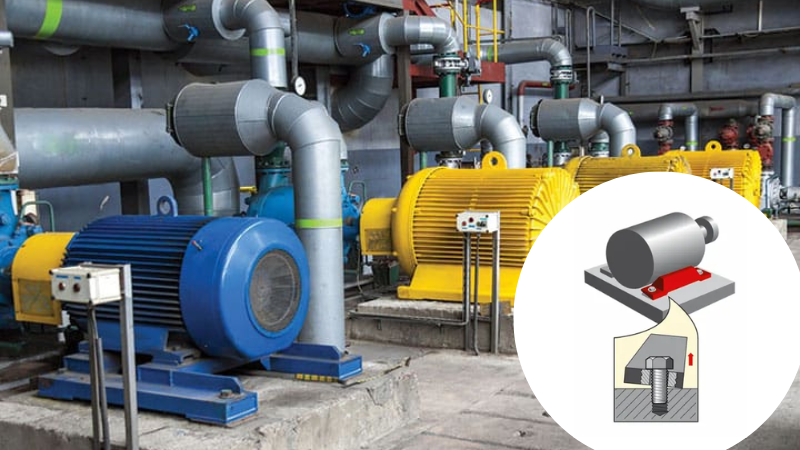Soft foot, a seemingly simple term, can cause significant headaches for industrial maintenance professionals. While often associated with motors, it poses a major challenge during shaft alignment, leading to inconsistencies and inaccurate results. This article delves into the intricacies of soft foot, equipping you with the knowledge to identify, address, and prevent this common issue.
Understanding Soft Foot
Imagine a motor wobbling precariously on its baseplate, resembling a child’s seesaw. This uneven support, where one or more feet lack proper contact with the base, is precisely what defines soft foot. It arises from various factors, including:
- Uneven foundation or baseplate: Faulty construction or settling over time can create an uneven surface.
- Twisted or damaged feet: Bent or cracked motor feet compromise proper contact.
- Improper shimming: Over Reliance on shims to correct alignment can mask underlying soft foot problems.
Consequences of Soft Foot
Ignoring soft foot can have detrimental consequences for your equipment:
- Inaccurate shaft alignment: The distorted motor frame throws off alignment measurements, leading to incorrect adjustments and persistent vibration.
- Increased wear and tear: Uneven load distribution accelerates bearing wear, shaft misalignment, and potential seal failures.
- Reduced pump efficiency: The additional energy wasted in overcoming the wobble translates to higher operating costs.
Identifying Soft Foot
Several methods can help identify soft foot, including:
- Dial gauges: These traditional tools measure the gap between the motor foot and the baseplate under loosened and tightened bolt conditions.
- Laser alignment tools: Advanced methods like laser shaft alignment can indirectly detect soft foot by analysing shaft movement during the loosening and tightening process.
Common Soft Foot Questions Answered
1. What is a soft foot indication?
Soft foot typically manifests as two diagonally opposed feet rocking on the base, creating an air gap under one foot when the other three are tightened.
2. What is the formula for soft foot correction?
This formula applies specifically to diagonal soft foot correction. While not universally applicable, it provides a general approach:
- Add the soft foot values of the highest feet: (Highest value 1 + Highest value 2)
- Subtract the lowest value from the sum: (Sum – Lowest value)
- Multiply by 0.8: (Result x 0.8)
- Divide by 2: (Result / 2)
- The resulting value represents the shim thickness required under each of the high soft foot feet.
Example Calculation:
Where:
- Rear left foot is 0.24″.
- Front Left foot is 0.003″.
- Rear right foot is 0.001″.
- Front right foot is 0.015″.
- Add the soft foot values of the highest feet: 0.024″ + 0.015″ = 0.039″
- Subtract the lowest, from the highest: 0.039 – 0.004″ = 0.035″
- Multiply by 0.8: 0.035 x 0. = 0.028″
- Divide these results by 2: 0.028 / 2 = 0.014″ shim under each of the feet with the high soft foot values.
3. What is the maximum permissible soft foot?
While ideally there should be no soft foot, the industry standard allows a maximum of 2 thousandths of an inch (0.025 mm).
4. What are the different types of soft foot?
There are 4 different types of soft foot:
- Parallel: Two diagonally opposed feet have equal soft foot or a stepped base issue.
- Angular: One foot or the base has an angular face.
- Squishy: The shim or base under one foot is distorted, offering resistance when loosened.
- Induced (external force): Stressed pipes connected to the equipment distort the frame when feet are loosened.
5. What is the difference between soft foot and looseness?
Soft foot is an issue with the mounting of an item to a base, while looseness could be a moment or structural issue with the base itself or the equipment frame.
Addressing Soft Foot
The primary solution for soft foot involves shimming the affected foot to eliminate or reduce the gap. However, in some cases, addressing the base or stressed pipework might be necessary.
Quantum Plant Maintenance: Your Soft Foot Elimination Partner
Identifying and resolving soft foot is one of many problems we check for through our Laser Alignment services.
A regular maintenance regime is vital for ensuring the optimal performance, longevity, and smooth operation of your industrial equipment. Regular inspections and proactive maintenance are key to preventing soft foot and its associated problems.
Contact QPM to book an on-site inspection.


